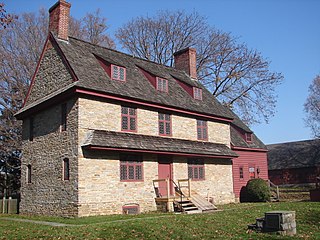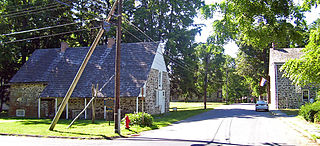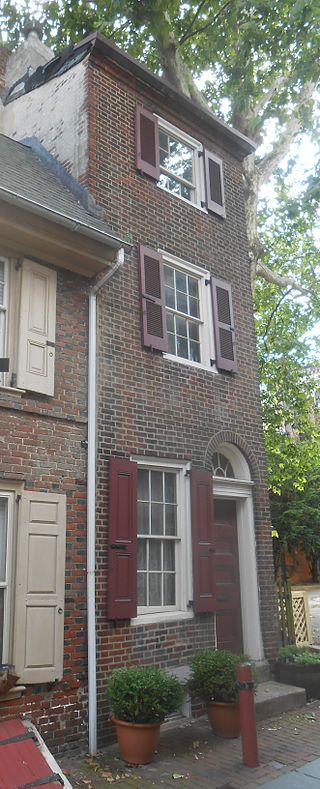
Nicodemus National Historic Site, located in Nicodemus, Kansas, United States, preserves, protects and interprets the only remaining western town established by African Americans during the Reconstruction Period following the American Civil War. The town of Nicodemus is symbolic of the pioneer spirit of African Americans who dared to leave the only region they had been familiar with to seek personal freedom and the opportunity to develop their talents and capabilities. The site was named, at least in part, for a legendary African-American slave featured in abolitionist Henry Clay Work's "Wake, Nicodemus (1864)." It is a mystical story of an old slave died away and buried in a hollow tree who had asked to be awakened on the Day of Jubilee.

Old City is a neighborhood in Center City, Philadelphia, Pennsylvania, United States, near the Delaware River waterfront. It is home to Independence National Historical Park, a dense section of historic landmarks including Independence Hall, the Liberty Bell, the First Bank of the United States, the Second Bank of the United States, and Carpenters' Hall. It also includes historic streets such as Elfreth's Alley, dating back to 1703.

Fredericksburg and Spotsylvania National Military Park is a unit of the National Park Service in Fredericksburg, Virginia, and elsewhere in Spotsylvania County, commemorating four major battles in the American Civil War: Fredericksburg, Chancellorsville, The Wilderness, and Spotsylvania.

Gloria Dei Church, known locally as Old Swedes', is a historic church located in the Southwark neighborhood of Philadelphia, Pennsylvania, at 929 South Water Street, bounded by Christian Street on the north, South Christopher Columbus Boulevard on the east, and Washington Avenue on the south. It was built between 1698 and 1700, making it the oldest church in Pennsylvania and second oldest Swedish church in the United States after Holy Trinity Church in Wilmington, Delaware.

The Ybor City Historic District is a U.S. National Historic Landmark District located in Ybor City, Tampa, Florida. The district is bounded by 6th Avenue, 13th Street, 10th Avenue and 22nd Street, East Broadway between 13th and 22nd Streets. Ybor City contains a total of 956 historic buildings, including an unparalleled collection of architecture with Spanish-Cuban influence, as well as historic cigar factory buildings and associated infrastructure. The area was developed by businessman Vicente Martinez Ybor beginning in 1886, and was for a time the world's leading supplier of cigars.

The William Brinton 1704 House is an historic house museum which is located at 21 Oakland Road in Delaware County, Pennsylvania, roughly five miles south of West Chester, Pennsylvania. Built in 1704, it is a well-preserved example of an early Delaware Valley stone house that served as a residence of one family for more than 150 years.

Historic Huguenot Street is located in New Paltz, New York, approximately 90 miles (140 km) north of New York City. The seven stone houses and several accompanying structures in the 10-acre National Landmark Historic District were likely built in the early 18th century by Huguenot settlers fleeing discrimination and religious persecution in France and what's now southern Belgium. After negotiating with the Esopus Indians, this small group of Huguenots settled on a flat rise on the banks of the Wallkill River in 1678. The settlers named the site in honor of Die Pfalz, the region of present-day Germany that had provided them temporary refuge before they came to America. Archaeological finds indicate that the immediate area settled by the Huguenots was occupied by Native Americans prior to European contact. The site is one of the oldest continuously inhabited settlements in the United States.

Belmont Mansion is a historic mansion located in Fairmount Park in Philadelphia. Built in the early 18th century, the mansion is one of the finest examples of Palladian architecture in the United States. Since 2007, the mansion has hosted the Underground Railroad Museum.

Stenton, also known as the James Logan Home, was the country home of James Logan, the first Mayor of Philadelphia and Chief Justice of the Pennsylvania Supreme Court during the colonial-era governance of the Province of Pennsylvania. The home is located at 4601 North 18th Street in the Logan neighborhood of North Philadelphia.

The Montgomery–Grand–Liberty Streets historic district was the first of two to be designated in the city of Newburgh, New York, United States. It runs along the three named north-south streets in the northeast quadrant of the city and includes 250 buildings in its 1,010 acres (4.1 km2). The later East End Historic District is nearby.

The John Coltrane House is a historic house at 1511 North 33rd Street in Philadelphia, Pennsylvania, USA. A National Historic Landmark, it was the home of American saxophonist and jazz pioneer John Coltrane from 1952 until 1958. On his death in 1967 the house passed to his cousin, who sold it in 2004. Efforts for restoration and reuse as a jazz venue are struggling. In 2022, two of Coltrane's sons filed a lawsuit contesting the ownership of the home.

The Reynolds-Morris House is an historic house which is located at 225 South 8th Street in the Washington Square West neighborhood of Philadelphia, Pennsylvania. Built between 1786 and 1787 by John and William Reynolds, it is a well-preserved example of a Philadelphia Georgian townhouse.

Historic RittenhouseTown, sometimes referred to as Rittenhouse Historic District, encompasses the remains of an early industrial community which was the site of the first paper mill in British North America. The mill was built in 1690 by William Rittenhouse and his son Nicholas on the north bank of Paper Mill Run near Philadelphia, Pennsylvania. The district, off Lincoln Drive near Wissahickon Avenue in Fairmount Park, includes six of up to forty-five original buildings. RittenhouseTown was listed on the National Register of Historic Places and was designated a National Historic Landmark District on April 27, 1992.

The Philadelphia Lazaretto was the Second quarantine hospital in the United States, built in 1799, in Tinicum Township, Delaware County, Pennsylvania. The site was originally inhabited by the Lenni Lenape, and then the first Swedish settlers. Nearby Province Island was the site of the confinement of the Christian Moravian Indians who were brought there under protective custody from Lancaster, Pennsylvania, in 1763 when their lives were threatened by the Paxton Boys. The facility predates similar national landmarks such as Ellis Island Immigrant Hospital and Angel Island and is considered both the oldest surviving quarantine hospital and the last surviving example of its type in the U.S.

Mount Harmon is an historic home, located at Earleville, Cecil County, Maryland, United States. It was listed on the National Register of Historic Places in 1974, and is currently open to the public.

Wyckoff Heights is an area within the New York City boroughs of Brooklyn and Queens, straddling the border between Bushwick, Brooklyn, and southwest Ridgewood, Queens. Wyckoff Heights was urbanized starting in the late 19th century, and took its name from the Wyckoff family, who owned the land. The area was home first to many German immigrants, later followed by Italian and more recently Latino and Eastern-European residents.

The Kingston Stockade District is an eight-block area in the western section of Kingston, New York, United States, commonly referred to as Uptown Kingston. It is the original site of the mid-17th century Dutch settlement of Wiltwyck, which was later renamed Kingston when it passed to English control.

East Jersey Old Town Village is an open-air museum located in Johnson Park in Piscataway, New Jersey. The Village is a collection of Raritan Valley area historic buildings and includes original, reconstructed, and replicated 18th and 19th century vernacular architecture typical of farm and merchant communities of Central Jersey. It is home to a permanent exhibition about Raritan Landing, an 18th-century inland port once located just downstream on the river. Since 1989, the Middlesex County Office of Arts and History has had responsibility for the village.

Naval Square is a gated community within the Graduate Hospital neighborhood of Philadelphia that served as the first United States Naval Academy from 1834 to 1845, when the Naval Academy formed in Annapolis. It continued as a retirement home for sailors and marines and was called the Naval Home until 1976, when the facility was relocated to Mississippi.

A Trinity house, also known as a band-box house or a Father, Son & Holy Ghost house, is a small townhouse, principally found in Philadelphia, Pennsylvania. Trinity houses are characterized by small size, with three or four floors vertically stacked, each usually consisting of one principal room, many of which were built in the 18th and 19th centuries. They are joined by small, winding stairways, and have few or no interior doors. The "Trinity" name is derived from three floors, three rooms. Kitchens are usually in the basement, with very low headroom. Houses are typically smaller than 1,000 square feet (93 m2), and about 14 feet (4.3 m) wide. The selection of furnishings for such houses is strictly limited by the difficulty of moving furniture between floors.

























